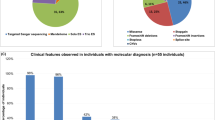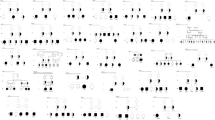Abstract
Background:
We had previously shown that arcuate fasciculus is poorly developed in patients with intellectual and developmental disabilities (IDD) using diffusion tensor imaging (DTI). In the present study, we used exome sequencing to identify the candidate variants in IDD patients with and without DTI abnormalities.
Methods:
Eighteen children with IDD (age: 67 ± 36 mo, 9 females) were included in the present study. The DTI was used to determine the integrity of arcuate fasciculus. The next-generation sequencing was performed on the Solid 4 platform. A novel, analytical strategy was developed to identify a set of candidate genes of interest. We then searched for novel, nonsynonymous variants in the patients within this subset of genes and in known IDD genes.
Results:
Seven novel, nonsynonymous (all of them were heterozygous, missense) variants belonged to ultraconserved genes that are known to cause abnormal brain morphology in mutant mice. Similarly, three novel, nonsynonymous (all of them were heterozygous, missense) variants belonged to known IDD genes. Two patients with underdeveloped arcuate fasciculus had novel, nonsynonymous variants in genes (MID1 and EN2) regulating axon guidance pathway.
Conclusion:
Exome sequencing identified several new genetic causes of IDD.
Similar content being viewed by others
Log in or create a free account to read this content
Gain free access to this article, as well as selected content from this journal and more on nature.com
or
References
Miller DT, Adam MP, Aradhya S, et al. Consensus statement: chromosomal microarray is a first-tier clinical diagnostic test for individuals with developmental disabilities or congenital anomalies. Am J Hum Genet 2010;86:749–64.
Gopal SP, Tiwari VN, Veenstra AL, et al. Sensitive diffusion tensor imaging quantification method to identify language pathway abnormalities in children with developmental delay. J Pediatr 2012;160:147–51.
Jeong JW, Sundaram SK, Kumar A, Chugani DC, Chugani HT . Aberrant diffusion and geometric properties in the left arcuate fasciculus of developmentally delayed children: a diffusion tensor imaging study. AJNR Am J Neuroradiol 2011;32:323–30.
Sundaram SK, Sivaswamy L, Makki MI, Behen ME, Chugani HT . Absence of arcuate fasciculus in children with global developmental delay of unknown etiology: a diffusion tensor imaging study. J Pediatr 2008;152:250–5.
Fletcher PT, Whitaker RT, Tao R, et al. Microstructural connectivity of the arcuate fasciculus in adolescents with high-functioning autism. Neuroimage 2010;51:1117–25.
Peters SU, Kaufmann WE, Bacino CA, et al. Alterations in white matter pathways in Angelman syndrome. Dev Med Child Neurol 2011;53:361–7.
Wilson BJ, Sundaram SK, Huq AH, et al. Abnormal language pathway in children with Angelman syndrome. Pediatr Neurol 2011;44:350–6.
Saporta AS, Kumar A, Govindan RM, Sundaram SK, Chugani HT . Arcuate fasciculus and speech in congenital bilateral perisylvian syndrome. Pediatr Neurol 2011;44:270–4.
Ng SB, Bigham AW, Buckingham KJ, et al. Exome sequencing identifies MLL2 mutations as a cause of Kabuki syndrome. Nat Genet 2010;42:790–3.
Ng SB, Turner EH, Robertson PD, et al. Targeted capture and massively parallel sequencing of 12 human exomes. Nature 2009;461:272–6.
Alvarado DM, Buchan JG, Gurnett CA, Dobbs MB . Exome sequencing identifies an MYH3 mutation in a family with distal arthrogryposis type 1. J Bone Joint Surg Am 2011;93:1045–50.
Sanders SJ, Murtha MT, Gupta AR, et al. De novo mutations revealed by whole-exome sequencing are strongly associated with autism. Nature 2012;485:237–41.
Chilton JK . Molecular mechanisms of axon guidance. Dev Biol 2006;292:13–24.
Liu QX, Hiramoto M, Ueda H, Gojobori T, Hiromi Y, Hirose S . Midline governs axon pathfinding by coordinating expression of two major guidance systems. Genes Dev 2009;23:1165–70.
Beaty TH, Murray JC, Marazita ML, et al. A genome-wide association study of cleft lip with and without cleft palate identifies risk variants near MAFB and ABCA4. Nat Genet 2010;42:525–9.
The Jackson Laboratory, Mammalian Phenotype Browser, 2013. http://www.informatics.jax.org/javawi2/servlet/WIFetch?page=alleleDetail&id=MGI:1856419.
The Jackson Laboratory, Mammalian Phenotype Browser, 2013. http://www.informatics.jax.org/javawi2/servlet/WIFetch?page=alleleDetail&id=MGI:1856176.
The Jackson Laboratory, Mammalian Phenotype Browser, 2013. http://www.informatics.jax.org/javawi2/servlet/WIFetch?page=alleleDetail&id=MGI:1856363.
Sundaram SK, Huq AM, Sun Z, et al. Exome sequencing of a pedigree with Tourette syndrome or chronic tic disorder. Ann Neurol 2011;69:901–4.
Vissers LE, de Ligt J, Gilissen C, et al. A de novo paradigm for mental retardation. Nat Genet 2010;42:1109–12.
The Jackson Laboratory, Mammalian Phenotype Browser, 2013. http://www.informatics.jax.org/mgihome/homepages/stats/all_stats.shtml.
Brunet I, Weinl C, Piper M, et al. The transcription factor Engrailed-2 guides retinal axons. Nature 2005;438:94–8.
Marín O . Thalamocortical topography reloaded: it’s not where you go, but how you get there. Neuron 2003;39:388–91.
Author information
Authors and Affiliations
Corresponding author
Supplementary information
Supplementary Figure S1.
(TIFF 665 kb)
PowerPoint slides
Rights and permissions
About this article
Cite this article
Sundaram, S., Huq, A., Hsia, T. et al. Exome sequencing and diffusion tensor imaging in developmental disabilities. Pediatr Res 75, 443–447 (2014). https://doi.org/10.1038/pr.2013.234
Received:
Accepted:
Published:
Issue date:
DOI: https://doi.org/10.1038/pr.2013.234
This article is cited by
-
Prevalence of four Mendelian disorders associated with autism in 2392 affected families
Journal of Human Genetics (2017)



